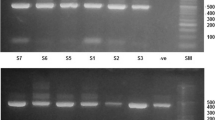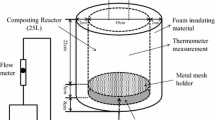Abstract
Composting has become an alternative for the treatment of organic effluents, due to its low cost, easy handling, and a great capacity for treating swine manure. As it is a biological process, many microorganisms are involved during the composting process and act in the degradation of organic matter and nutrients and also have the ability to degrade contaminants and accelerate the transformations during composting. The objective of this work was to identify microorganisms present in the swine effluent composting system, under the contamination by most used veterinary drugs in Brazil. The composting took place for 150 days, there was an addition of 200 L of manure (these 25 L initially contaminated with 17 antibiotics) in 25 kg of eucalyptus wood shavings. The microorganisms were measured at times (0 until 150 days) and were identified by the V3-V4 regions of the 16S rRNA for Bacteria, by means of next-generation sequencing (NSG). The results show seven different bacterial phyla (Proteobacteria, Bacteroidetes, Firmicutes, Acidobacteria, Actinobacteria, Spirochaetota and Tenericutes) and 70 bacterial genera (more than 1% significance), of which the most significant ones were Pseudomonas, Sphingobacterium, Devosia, Brucella, Flavisolibacter, Sphingomonas and Nitratireductor. The genus Brucella was found during mesophilic and thermophilic phases, and this genus has not yet been reported an in article involving composting process. With the results obtained, the potential for adaptation of the bacterial community was observed, being under the influence of antibiotics for veterinary use.





Similar content being viewed by others
Data availability
I declare that I provide all the data for the publication of the article in the aforementioned journal.
References
Awasthi MK, Zhang Z, Wang Q, Shen F, Li R, Li DS, Ren X, Wang M, Chen H, Zhao J (2017) New insight with the effects of biochar amendment on bacterial diversity as indicators of biomarkers support the thermophilic phase during sewage sludge composting. Bioresour Technol 238:589–601. https://doi.org/10.1016/j.biortech.2017.04.100
Bao Y, Zhou Q, Guan L, Wang Y (2009) Depletion of chlortetracycline during composting of aged and spiked manures. Waste Manag 29:1416–1423. https://doi.org/10.1016/j.wasman.2008.08.022
Ben W, Wang J, Pan X, Qiang Z (2017) Dissemination of antibiotic resistance genes and their potential removal by on-farm treatment processes in nine swine feedlots in Shandong Province, China. Chemosphere 167:262–268. https://doi.org/10.1016/j.chemosphere.2016.10.013
Bohrer REG, Carissimi E, Wolf DB, Prestes OD, Zanella R, Rizzetti TM, Lopez DAR, Machado ÊL, da Silva DM (2020) Removal of high concentrations of veterinary antibiotics through co-composting of swine waste. Waste Biomass Valoriz. https://doi.org/10.1007/s12649-020-00952-3
Chen Z, Zhang S, Wen Q, Zheng J (2015) Effect of aeration rate on composting of penicillin mycelial dreg. J Environ Sci 37:172–178. https://doi.org/10.1016/j.jes.2015.03.020
Chi CP, Chu S, Wang B, Zhang D, Zhi Y, Yang X, Zhou P (2020) Dynamic bacterial assembly driven by Streptomyces griseorubens JSD-1 inoculants correspond to composting performance in swine manure and rice straw co-composting. Bioresour Technol 313:123692. https://doi.org/10.1016/j.biortech.2020.123692
Christoff AP, Sereia AFR, Boberg DR, De Moraes RLV, De Oliveira LFV (2017) Bacterial identification through accurate library preparation and high-throughput sequencing. White Pap. Bact. NGS Seq. https://neoprospecta.s3.amazonaws.com/docs/Neoprospecta+-+White+Paper+-+Bacterial+NGS+sequencing+2017.pdf
Ezzariai A, Barret M, Merlina G, Pinelli E, Hafidi M (2017) Evaluation of the antibiotics effects on the physical and chemical parameters during the co-composting of sewage sludge with palm wastes in a bioreactor. Waste Manag 68:388–397. https://doi.org/10.1016/j.wasman.2017.06.036
Franke-Whittle IH, Confalonieri A, Insam H, Schlegelmilch M, Körner I (2014) Changes in the microbial communities during co-composting of digestates. Waste Manag 34:632–641. https://doi.org/10.1016/j.wasman.2013.12.009
Gou M, Hu HW, Zhang YJ, Wang JT, Hayden H, Tang YQ, He JZ (2018) Aerobic composting reduces antibiotic resistance genes in cattle manure and the resistome dissemination in agricultural soils. Sci Total Environ 612:1300–1310. https://doi.org/10.1016/j.scitotenv.2017.09.028
Gusain R, Pandey B, Suthar S (2018) Composting as a sustainable option for managing biomass of aquatic weed pistia: a biological hazard to aquatic system. J Clean Prod 177:803–812. https://doi.org/10.1016/j.jclepro.2017.12.261
Hu J, Zhou J, Zhou S, Wu P, Tsang YF (2018) Occurrence and fate of antibiotics in a wastewater treatment plant and their biological effects on receiving waters in Guizhou. Process Saf Environ Prot 113:483–490. https://doi.org/10.1016/j.psep.2017.12.003
Lalsiamthara J, Lee JH (2018) Immunization of guinea pigs with Salmonella delivered anti-Brucella formulation reduces organs bacterial load and mitigates histopathological consequences of Brucella abortus 544 challenge. Vet Immunol Immunopathol 195:40–45. https://doi.org/10.1016/j.vetimm.2017.11.006
Li C, Chen J, Wang J, Ma Z, Han P, Luan Y, Lu A (2015) Occurrence of antibiotics in soils and manures from greenhouse vegetable production bases of Beijing, China and an associated risk assessment. Sci Total Environ 19:521–522. https://doi.org/10.1016/j.scitotenv.2015.03.070
Liu B, Li Y, Zhang X, Feng C, Gao M, Shen Q (2015) Effects of composting process on the dissipation of extractable sulfonamides in swine manure. Bioresour Technol 175:284–290. https://doi.org/10.1016/j.biortech.2014.10.098
Liu L, Wang S, Guo X, Zhao T, Zhang B (2017) Succession and diversity of microorganisms and their association with physicochemical properties during green waste thermophilic composting. Waste Manag. https://doi.org/10.1016/j.wasman.2017.12.026
López-González JA, Suárez-Estrella F, Vargas-García MC, López MJ, Jurado MM, Moreno J (2015) Dynamics of bacterial microbiota during lignocellulosic waste composting: studies upon its structure, functionality and biodiversity. Bioresour Technol 175:406–416. https://doi.org/10.1016/j.biortech.2014.10.123
Ma S, Fang C, Sun X, Han L, He X, Huang G (2018) Bacterial community succession during pig manure and wheat straw aerobic composting covered with a semi-permeable membrane under slight positive pressure. Bioresour Technol 259:221–227. https://doi.org/10.1016/j.biortech.2018.03.054
Ma W, Wang L, Xu X et al (2022) Fate and exposure risk of florfenicol, thiamphenicol and antibiotic resistance genes during composting of swine manure. Sci Total Environ. https://doi.org/10.1016/j.scitotenv.2022.156243
Mao H, Lv Z, Sun H, Li R, Zhai B, Wang Z, Awasthi MK, Wang Q, Zhou L (2018) Improvement of biochar and bacterial powder addition on gaseous emission and bacterial community in pig manure compost. Bioresour. Technol. 258:195–202. https://doi.org/10.1016/j.biortech.2018.02.082
Meng X, Liu B, Xi C, Luo X, Yuan X, Wang X, Zhu W, Wang H, Cui Z (2018) Effect of pig manure on the chemical composition and microbial diversity during co-composting with spent mushroom substrate and rice husks. Bioresour Technol 251:22–30. https://doi.org/10.1016/j.biortech.2017.09.077
Mojica E, Aga DS (2011) Antibiotics pollution in soil and water : potential ecological and human health issues. Encycl Environ Heal. https://doi.org/10.1016/B978-0-444-52272-6.00338-X
Nguyen TKX, Thayanukul P, Pinyakong O, Suttinun O (2017) Tiamulin removal by wood-rot fungi isolated from swine farms and role of ligninolytic enzymes. Int Biodeterior Biodegradation 116:147–154. https://doi.org/10.1016/j.ibiod.2016.10.010
Onwosi CO, Igbokwe VC, Odimba JN, Eke IE, Nwankwoala MO, Iroh IN, Ezeogu LI (2017) Composting technology in waste stabilization: on the methods, challenges and future prospects. J Environ Manage 190:140–157. https://doi.org/10.1016/j.jenvman.2016.12.051
Qian X, Sun W, Gu J, Wang XJ, Sun JJ, Yin YN, Duan ML (2016) Variable effects of oxytetracycline on antibiotic resistance gene abundance and the bacterial community during aerobic composting of cow manure. J Hazard Mater 315:61–69. https://doi.org/10.1016/j.jhazmat.2016.05.002
Ryckeboer J, Mergaert J, Vaes K, Klammer S, Clercq D, Coosemans J, Insam H, Swings J (2003) A survey of bacteria and fungi occurring during composting and self-heating processes. Ann Microbiol 53:349–410
Sánchez ÓJ, Ospina DA, Montoya S (2017) Compost supplementation with nutrients and microorganisms in composting process. Waste Manag 69:136–153. https://doi.org/10.1016/j.wasman.2017.08.012
Segura PA, Takada H, Correa JA, Saadi K, Koike T, Onwona-agyenan S, Ofosu-anim J, Sabi EB, Wasonga OV, Maghalu JM, Santos AM, Newman B, Weerts S, Yargeau V (2015) Global occurrence of anti-infectives in contaminated surface waters: impact of income inequality between countries. Environ Int Sherbrooke 80:89–97. https://doi.org/10.1016/j.envint.2015.04.001
Selvam A, Zhao Z, Wong JWC (2012) Composting of swine manure spiked with sulfadiazine, chlortetracycline and ciprofloxacin. Bioresour Technol 126:412–417. https://doi.org/10.1016/j.biortech.2011.12.073
Steel H, Moens T, Vandecasteele B, Hendrickx F, De Neve S, Neher DA, Bert W (2018) Factors influencing the nematode community during composting and nematode-based criteria for compost maturity. Ecol Indic 85:409–421. https://doi.org/10.1016/j.ecolind.2017.10.039
Tian W, Sun Q, Xu D, Zhang Z, Chen D, Li C, Shen Q, Shen B (2013) Succession of bacterial communities during composting process as detected by 16S rRNA clone libraries analysis. Int Biodeterior Biodegrad 78:58–66. https://doi.org/10.1016/j.ibiod.2012.12.008
Wang J, Ben W, Yang M, Zhang Y, Qiang Z (2016) Dissemination of veterinary antibiotics and corresponding resistance genes from a concentrated swine feedlot along the waste treatment paths. Environ Int 92–93:317–323. https://doi.org/10.1016/j.envint.2016.04.020
Wang K, Chu C, Li X, Wang W, Ren N (2018) Succession of bacterial community function in cow manure composing corresponding author : bioresour. Technol. https://doi.org/10.1016/j.biortech.2018.06.028
Wang X, Wan J, Jiang G, Yang T, Banerjee S, Wei Z, Mei X, Friman V-P, Xu Y, Shen Q (2021) Compositional and functional succession of bacterial and fungal communities is associated with changes in abiotic properties during pig manure composting. Waste Manag 131:350–358. https://doi.org/10.1016/j.wasman.2021.06.023
Xu X, Ma W, Zhou K et al (2022) Effects of composting on the fate of doxycycline, microbial community, and antibiotic resistance genes in swine manure and broiler manure. Sci Total Environ. https://doi.org/10.1016/j.scitotenv.2022.155039
Yang F, Li G, Shi H, Wang Y (2015) Effects of phosphogypsum and superphosphate on compost maturity and gaseous emissions during kitchen waste composting. Waste Manag 36:70–76. https://doi.org/10.1016/J.WASMAN.2014.11.012
Yin Y, Gu J, Wang X, Zhang K, Hu T, Ma J, Wang Q (2018) Impact of copper on the diazotroph abundance and community composition during swine manure composting. Bioresour Technol 255:257–265. https://doi.org/10.1016/j.biortech.2018.01.120
Zhang Z, Shen J, Wang H, Liu M, Wu L, Ping F, He Q, Li H, Zheng C, Xu X (2014) Attenuation of veterinary antibiotics in full-scale vermicomposting of swine manure via the housefly larvae (Musca domestica). Sci Rep 4:6844. https://doi.org/10.1038/srep06844
Zhang M, Liu Y, Zhao J, Liu W, He L, Zhang J (2018) Occurrence, fate and mass loadings of antibiotics in two swine wastewater treatment systems. Sci Total Environ 639:1421–1431. https://doi.org/10.1016/j.scitotenv.2018.05.230
Zhao X, Wang J, Zhu L, Ge W, Wang J (2017) Environmental analysis of typical antibiotic-resistant bacteria and ARGs in farmland soil chronically fertilized with chicken manure. Sci Total Environ 593:10–17. https://doi.org/10.1016/j.scitotenv.2017.03.062
Zhong XZ, Ma SC, Wang SP, Wang TT, Sun ZY, Tang YQ, Deng Y, Kida K (2018) A comparative study of composting the solid fraction of dairy manure with or without bulking material: performance and microbial community dynamics. Bioresour Technol 247:443–452. https://doi.org/10.1016/j.biortech.2017.09.116
Acknowledgments
The authors would like to thank the Graduate Program in Civil Engineering and the Graduate Program in Chemistry at the Federal University of Santa Maria—UFSM, and the State University of Rio Grande do Sul (UERGS)—Campus Três Passos—RS, for supporting the research.
Funding
This work did not have the help of any funding agency to carry out the research.
Author information
Authors and Affiliations
Corresponding author
Ethics declarations
Conflict of interest
The authors have not disclosed any funding.
Additional information
Communicated by Erko Stackebrandt.
Publisher's Note
Springer Nature remains neutral with regard to jurisdictional claims in published maps and institutional affiliations.
Rights and permissions
Springer Nature or its licensor (e.g. a society or other partner) holds exclusive rights to this article under a publishing agreement with the author(s) or other rightsholder(s); author self-archiving of the accepted manuscript version of this article is solely governed by the terms of such publishing agreement and applicable law.
About this article
Cite this article
Bohrer, R.E.G., Carissimi, E., Guerra, D. et al. Evaluation of bacterial diversity in a swine manure composting system contaminated with veterinary antibiotics (VAs). Arch Microbiol 205, 85 (2023). https://doi.org/10.1007/s00203-022-03382-y
Received:
Revised:
Accepted:
Published:
DOI: https://doi.org/10.1007/s00203-022-03382-y




